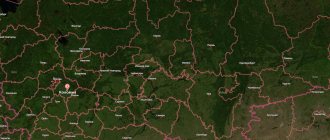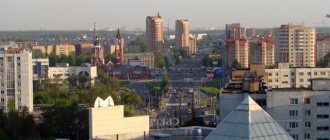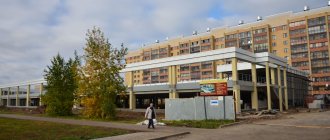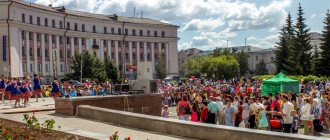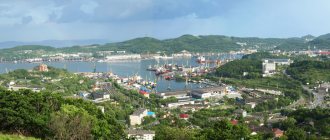Historical facts
- 1339 - the first documentary mention of the village of Fominskoye, which arose on the Nara River.
- 1654 - by decree of the tsar, the village was assigned to the Zvenigorod Savvino-Storozhevsky monastery.
- October 1812 - Napoleon’s retreating army passes through the village of Fominskoye.
- 1840 - foundation of a paper spinning factory, which would later become a city-forming enterprise.
- 1864 - unification of the villages of Fominskoye and Malaya Nara.
- 1892 - construction of a new weaving factory building, emergence of a workers' settlement.
- 1918 - the village of Naro-Fominskoye becomes the center of the district of the same name.
- 1926 - the workers' settlement receives city status.
- November-December 1941 - fierce fighting takes place in the city. More than 680 buildings were destroyed, including a weaving factory.
- 2009 - the city was awarded the honorary title “City of Military Glory”.
Naro-Fominsk on the map of Russia: geography, nature and climate
The city is located on the Nara River and its tributaries Berezovka and Gvozdnya , 8 km from the Trinity Administrative District.
The Naro-Fominsk administrative center is recognized as the best natural and climatic region in the region. There are many small-leaved and coniferous forests here. , Protva , and Pakhra rivers originate in the area .
The average winter temperature is -13 °C. In summer the thermometer rises to +25 °C.
Routes on the map of Naro-Fominsk. Transport infrastructure
Municipal public transport is represented by 20 bus routes, some of which may change depending on the season. Minibus taxis follow bus routes and also run their own routes.
Kievskoye Highway , passing near the city, is a federal highway. It connects Naro-Fominsk with Moscow and Vnukovo airport, leading to Obninsk, Maloyaroslavets, Kaluga, Bryansk. As an important transport hub, the city connects the Minskoe and Kievskoe highways.
a bus station in the city (Naro-Fominsk, Kurzenkova St.), located near the Nara railway station (24 Poluboyarova St., Naro-Fominsk). Some intercity routes depart from Nara-yuzhnaya station.
The Kiev direction railway line runs through Naro-Fominsk . The station is located in the city center (Poluboyarova St., 24, Naro-Fominsk) and connects all routes of city and intercity buses. It serves express trains and trains that go to Moscow, Kaluga and Maloyaroslavets.
Naro-Fominsk district, Moscow region
The Naro-Fominsk district was formed on July 12, 1929 as part of the Moscow district of the Moscow region on the territory of the former Naro-Fominsk and Petrovsk volosts of the Zvenigorod district of the Moscow province. The district included the city of Naro-Fominsk and village councils:
- from Naro-Fominsk volost: Arkhangelsky, Ateptsevo, Barkhatovsky, Bolshe-Gorkovsky, Bolshe-Semenychevsky, Golovenkinsky, Ivanovsky, Kamensky, Kotovsky, Kryukovsky, Lyubanovsky, Mishukovsky, Mogutovsky, Novinsky, Novofedorovsky, Plesensky, Rozhdestvensky, Tashirovsky, Cheshkovsky
- from Petrovskaya volost: Kuznetsovsky, Kutmenevsky, Novikovsky, Rasudovsky, Rudnevsky.
On May 20, 1930, Bolshe-Pokrovsky, Bolshe-Svinorsky, Glagolevsky, Davydkovsky, Ignatovsky, Ilyinsky, Krutilovsky, Lukinsky, Martemyanovsky, Marushkinsky, Petrovsky, Podosinkovsky and Taraskovsky village councils were transferred from the Zvenigorodsky district to Naro-Fominsky. At the same time, the Dyatlovsky and Novoselkovsky village councils were transferred from the Krasnopakhorsky district to the Naro-Fominsky district.
In 1931, Barkhatovsky, Ilyinsky, Kutmenevsky, Novoselkovsky, Plesnevsky and Podosinkovsky village councils were abolished.
By a resolution of the All-Russian Central Executive Committee of March 10, 1932, the Romanovsky village council was transferred from the Ugodsko-Zavodsky district to the Naro-Fominsk district[25].
On March 10, 1935, the working village of Aprelevka was formed. In the same year, the Krutilovsky village council was renamed Sofinsky, and Glagolevsky - Zhedochevsky.
On April 5, 1936, the Lukinsky and Novinsky village councils were abolished.
On November 3, 1938, the holiday village of Alabino was formed.
On July 17, 1939, Bolshe-Semenychevsky, Golovenkinsky, Davydkovsky, Ivanovsky, Mishukovsky, Novikovsky, Romanovsky, Rudnevsky and Sofinsky village councils were abolished. The Cheshkovsky village council was renamed Nastasinsky.
On June 14, 1954, Bashkinsky, Novikovsky and Pervomaisky village councils were formed. Arkhangelsk, Bolshe-Gorkovsky, Bolshe-Pokrovsky, Bolshe-Svinorsky, Dyatlovsky, Zhedochevsky, Ignatovsky, Kotovsky, Kuznetsovsky, Lyubanovsky, Mogutovsky, Nastasinsky, Rozhdestvensky and Taraskovsky village councils were abolished.
In 1956, the holiday village of Kokoshkino was formed.
On May 21, 1959, the Bashkinsky, Rasudovsky and Pervomaisky s/s were abolished. Novikovsky s/s was renamed Alabinsky. On June 3, the Vereisky district was abolished. From it, the Naro-Fominsk region included the city of Vereya; r.p. Dorokhovo; s/s Arkhangelsk, Afanasyevsky, Blagoveshchensky, Bogorodsky, Vyshegorodsky, Klinsky, Nazarevsky, Novoivanovsky, Pareevsky, Simbukhovsky, Fedyunkinsky and Shelkovsky. On August 29, the Alabinsky, Arkhangelsky, Bogorodsky, Klinsky, Martemyanovsky and Novoivanovsky s/s were abolished. Pareevsky s/s was renamed Shustikovsky.
On August 20, 1960, Pervomaisky s/s was transferred from the abolished Leninsky district to Naro-Fominsky.
August 15, 1961 r.p. Aprelevka was transformed into a city of district subordination (Decree of the Presidium of the Supreme Council of the RSFSR) (Vedomosti of the Supreme Council of the RSFSR. - 1961. - No. 32 (153) of August 17. - P. 473).
On February 1, 1963, the city of Naro-Fominsk was classified as a city of regional subordination (Decree of the Presidium of the Supreme Council of the RSFSR) (Vedomosti of the Supreme Council of the RSFSR. - 1963. - No. 5 (227) of February 7. - P. 161-162).
On February 1, 1963, the Naro-Fominsk district was abolished, part of its rural territory was transferred to the formed Mozhaisk enlarged rural district, but was restored on January 13, 1965. It included the cities of Aprelevka and Vereya; d.p. Alabino and Kokoshkino; s/s Ateptsevsky, Afanasyevsky, Veselevsky, Kamensky, Kryukovsky, Marushkinsky, Nazarevsky, Novofedorovsky, Pervomaisky, Petrovsky, Simbukhovsky, Tashirovsky and Shustikovsky.
On February 2, 1982, the village of Kyiv received the status of a working village.
On February 3, 1994, village councils were transformed into rural districts.
On February 1, 2001, the city of Naro-Fominsk lost its status as a city of regional subordination[26].
On July 22, 2004, the village of Selyatino, administratively subordinate to the dacha village of Alabino, was transformed into the working village of Selyatino[27], and the dacha village of Alabino was merged with the village of Alabino[28].
On July 11, 2006, the village of Kalininets was transformed into the working village of Kalininets[29].
On June 14, 2021, the working villages of Kalininets and Selyatino were transferred to the administrative subordination of the city of Naro-Fominsk[30].
On June 23, 2021, the rural settlements of Ateptsevskoye, Veselevskoye, Volchenkovskoye and Tashirovskoye[31] were abolished, and the cities of Aprelevka and Vereya were placed under the administrative subordination of the city of Naro-Fominsk[32].
On July 8, 2021, the city of Naro-Fominsk was classified as a city of regional subordination of the Moscow region, and the Naro-Fominsk district was abolished[33].
Sights of the city of Naro-Fominsk
Most of the city's attractions are associated with the military operations that took place here. On Victory Square there is a monument to the T-34 tank , in the children's park there is a Memorial Complex , and on Freedom Square there is a stele “City of Military Glory” . The local history museum houses exhibits telling the history of the city.
St. Nicholas Cathedral has been preserved in Naro-Fominsk . The temple is operational; services are held here on holidays.
Administrative subordination includes:
Cities:
- City of Naro-Fominsk
- Aprelevka city
- Vereya city
Settlements:
- Settlement of the Arkhangelsk temporary storage facility
- Settlement d/o Vereya
- Settlement of Dubki
- Settlement Krasnoarmeyskoye Lesnichestvo
- Settlement of Lespromkhoz
- Settlement Novaya Olkhovka
- Settlement d/o Excellent
- Settlement Pionersky
- Settlement Naro-Fominsk-11
- Settlement Alexandrovka
- Settlement Basic Nursery
- Settlement d/o Bekasovo
Work villages:
- Workers' settlement Kalininets
- Workers' village Selyatino
Villages:
- Village Akishevo
- Alekseevka village
- Aleksino village
- Alferyevo village
- Village Arkhangelskoye
- Village Afanasyevo
- Village Afineevo
- Village of Akhmatovo
- Bavykino village
- Belkovo village
- Village Beryulevo
- Annunciation Village
- Village Bloznevo
- Village Bolshie Gorki
- Village of Bolshie Semenychi
- Village Burtsevo
- Village Varvarino
- Village Vasilisino
- Village Vasilyevo
- Village Vasilchinovo
- Village Vaskino
- Verkhovye village
- Village of Veselevo
- Volkovo village
- Volchenki village
- Voskresenki village
- Village Vyshegorod
- Village Glagolevo
- Glinka village
- Village Godunovo
- Golovenki village
- Village Golovkovo
- Gorchukhino village
- Village Grigorovo
- Village Gulyai Gora
- Village Dedenevo
- Village Detenkovo
- Dubrovka village
- Village Dubrovo
- Village of Dudkino
- Village of Dyatlovo
- Village Elagino
- Village Eryukhino
- Village Efanovo
- Village Zhedochi
- Village Zhenatkino
- Village Zhikharevo
- Village Zagryazhskoe
- Village Zaluchnoe
- Village Zinaevka
- Zolotkovo village
- Village Zubovo
- Village Ivkovo
- Village Ilyinskoye
- Inevka village
- Village Kamenka
- Village Kaurtsevo
- Village Klin
- Village of Klovo
- Village Knyazevoe
- Village Kobyakovo
- Village Kovrigino
- Kolodezi village
- Village Korovino
- Kotovo village
- Peasant Village
- Village Kromino
- Village Kryukovo
- Village Kryukovo
- Village Kuzminskoye
- Kupelitsy village
- Village Kurapovo
- Village Lapino
- Latvian village
- Village Litvinovo
- Village Lobanovo
- Village of Luzhki
- Village Lukyanovo
- Village Lyubanovo
- Village Makarovka
- Village of Malye Gorki
- Village of Malye Semenychi
- Maltsevo village
- Village Martemyanovo
- Maurino village
- Village Melnikovo
- Village of Merchalovo
- Mitenino village
- Village Mityaevo
- Village Mishutkino
- Village Monakovo
- Village Myakishevo
- Village Embankment Sloboda
- Village Nazaryevo
- Village Nastasino
- Village Nefedovo
- Village Nechaevo
- Nikolskoye village
- Village Novaya
- Village Novinskoye
- Village Novoaleksandrovka
- Village Novoborisovka
- Village Novozybinka
- Village Novonikolskoye
- Novoselki village
- Village Nosovo
- Village Obukhovo
- Oreshkovo village
- Village Panovo
- Village Pafnutovka
- Village Pashkovo
- Village of Peremeshaevo
- Village of Pershino
- Village Petrovskoe
- Village Plaksino
- Village Plesenskoye
- Village Podolnoye
- Pokrovka village
- Village of Poryadino
- Pushkarka village
- Village Radchino
- Village Revyakino
- Redkino village
- Rozhdestveno village
- Village Christmas
- Village Romanovo
- Village Grove
- Village Rubtsovo
- Village Ryzhkovo
- Village Samorod
- Sanniki village
- Village Svitino
- Sekirino village
- Village Semenkovo
- Semidvore village
- Village Serenskoe
- Village Simbukhovo
- Village Skugorovo
- Village Slepushkino
- Village Sliznevo
- Village Smolino
- Sobakino village
- Village Sotnikovo
- Village Sofiino
- Village of Spas-Kositsy
- Village Stupino
- Village Subbotino
- Village Subbotino
- Sumino Village
- Village Syrevo
- Village Taraskovo
- Village Tatishchevo
- Village Tashirovo
- Village Teleshovo
- Timonino village
- Timofevo village
- Village Tishinka
- Tureika village
- Village Tyutchevo
- Village Ustye
- Fedyunkino village
- Village Khlopovo
- Village Cheblokovo
- Village Cheshkovo
- Village Chichkovo
- Shapkino village
- Shubino village
- Village Shustikovo
- Village Shchekutino
- Village Yumatovo
- Village Yushkovo
- Village Yastrebovo
- Village Selyatino
- Alabino village
- Bashkino village
- Village Novosumino
- Village of Novoglagolevo
- Village Ternovka
- Village Afanasovka
- Village Bekasovo
- Village Ivanovka
- Mogutovo village
- Savelovka village
- Village Lisintsevo
- Village Pozhitkovo
Villages:
- Village Kamenskoye
- Petrovskoe village
- Village Ateptsevo
Main streets of Naro-Fominsk
There are 120 streets in Naro-Fominsk, the largest of which are:
- Moskovskaya is the main highway of the city, originating from the Kiev highway. Passing through the Moscow microdistrict, it leads to the city center to the railway station.
- Marshal Zhukov starts from the transport ring near the City Administration, goes past the youth square to the Wedding Palace.
- Lenina Street is located in the Yuzhny microdistrict. On the map of Naro-Fominsk with streets you can see that it passes next to the Afghan Warriors Park.
- The Cuban highway leads from the city to the Naro-Fominsk highway.
- Volodarsky Street begins at Victory Square. It passes by the Naro-Fominsk Mosque and ends at the New Cemetery.
- Pogodina Street crosses the Berezovka microdistrict. The map of Naro-Fominsk with houses indicates that the Medical School is located on this street.
There are two squares in the city. Victory Square is a transport ring connecting the main streets of the city - Volodarskogo, Pl. Freedom and the Tunnel Dead End. Freedom Square is nearby.
Naro-Fominsk district is located in the southwest of the Moscow region. It borders with the Podolsk region (in the southeast), Odintsovo and Ruzsky districts (in the north), Mozhaisk (in the northwest) and with the Kaluga region (in the southwest). Length (from northeast to southwest) - 110 km. Number of settlements - 295. Cities and urban settlements - Naro-Fominsk (57 thousand people), Aprelevka (19.7 thousand people), Vereya (5 thousand people), Alabino, Kievsky, Kokoshkino. The number of rural districts is 13. In total, there are 310 settlements in the district. The administrative center is the city of Naro-Fominsk .
The area of the district is 1929 square meters. km. The population of the district is 168 thousand people.
People have long settled on the territory of the Naro-Fominsk region . They were attracted by the picturesque nature of the area with dense coniferous forests and clean rivers rich in fish. Events of ancient history left their mark on the system of numerous monuments. Evidence of ancient history are the various archaeological monuments located here: mounds, settlements, fortifications.
Today, the Naro-Fominsk district is one of the largest and most dynamically developing areas of the capital region with developed industry and agriculture. It also has developed industrial and agricultural sectors of the economy. According to a number of key indicators, the Naro-Fominsk district is leading in the Moscow region.
The Naro-Fominsk district is considered one of the most environmentally friendly areas of the Moscow region. A third of the entire area of the district is occupied by forests.
The main rivers are Nara , Protva , Pakhra , Desna . Other water bodies are represented mainly by small reservoirs and ponds.
The territory of the district is crossed by railways and highways of federal significance (M3 "Ukraine" Moscow - Kiev and the distance of the Kiev direction of the Moscow-Smolensk railway), ring railways (with a large sorting hub - Bekasovo station) and highways ( A-107 MMK) . At the northern and western borders of the district there are railways and highways of federal significance Moscow - Minsk.
Various types of historical, cultural and natural monuments are concentrated in the Naro-Fominsk region The most valuable of them are: archaeological monuments (burial grounds, settlements, settlements), monuments of religious architecture (churches, cathedrals, monasteries), estate complexes and monuments of “military glory”: - The Patriotic War of 1812 and the Great Patriotic War of 1941 - 1945 .
The next increase in the area of the district occurred in 1957, when the Naro-Fominsk district was replenished at the expense of the abolished Kalininsky district (now the territories adjacent to Moscow and the Leninsky district). And after 2 years, the Naro-Fominsk district almost completely absorbed the Vereisky district with the former regional center of the city of Vereya. In 1959, small parts of the Vereisky district were transferred to the Mozhaisk and Ruzsky districts of the region.
Naro-Fominsk is a veritable storehouse of Russian cultural objects that have not yet been discovered or are not used for widespread tourism and excursion business. Many Narofominsk residents simply do not realize how many historical treasures are located very close to them. Naro-Fominsk , Ryzhkovskoye settlement , Petrovskoye ancient settlement and many other archaeological sites.
Near the village of Kamenskoye there is St. Nicholas Church - a unique architectural monument of the turn of the 14th-15th centuries; In the village of Petrovskoye, a manor architectural complex has been preserved, including the current church of St. Peter the Metropolitan , the manor palace (in ruins), many other buildings erected by the great Russian architect M.F. Kazakov ; Tikhvin Church in Burtsevo, erected in 1708 in imitation of the cathedral of the Donskoy Monastery ; the remains of the Berg estate in Pervomaisky; the church on Posad in Vyshgorod and the church in the village of Spas-Kositsy . In Vereya, for example, it is impossible to immediately count how many temples there are. And a unique natural landscape!
Official website of the District Administration: www.narofominsk.ru/ Information and entertainment portal: https://n-f.rf
Economy and industry of Naro-Fominsk
The basis of the revenue side of the city budget is industry. There are 25 large enterprises operating in Naro-Fominsk.
- Keralit produces products from refractory materials.
- “Ball Beverage Packaging Naro-Fominsk” produces aluminum cans.
- “Salyut” is the production of parts for aircraft jet engines.
- “Naro-Fominsk Plastics Plant” produces plastic products for cultural and domestic needs.
- The Naro-Fominsky mother plant is an organizer and producer of regional nutrition in educational institutions.
